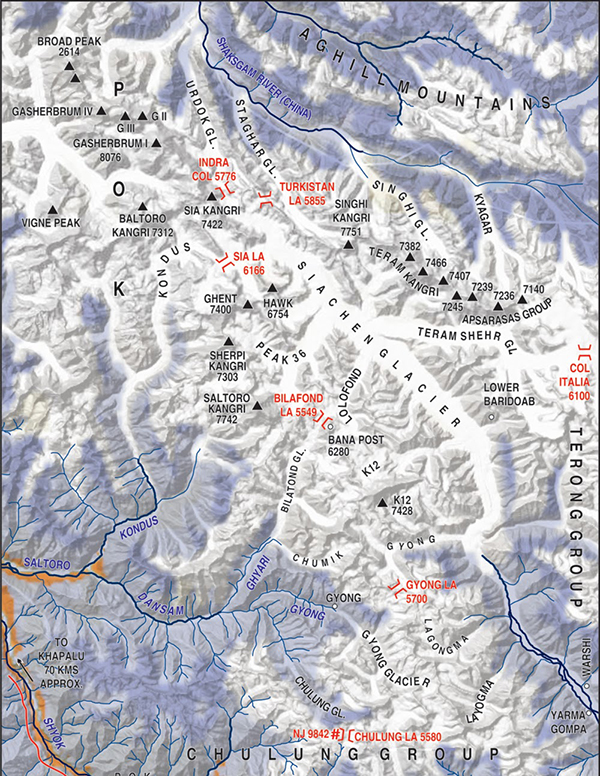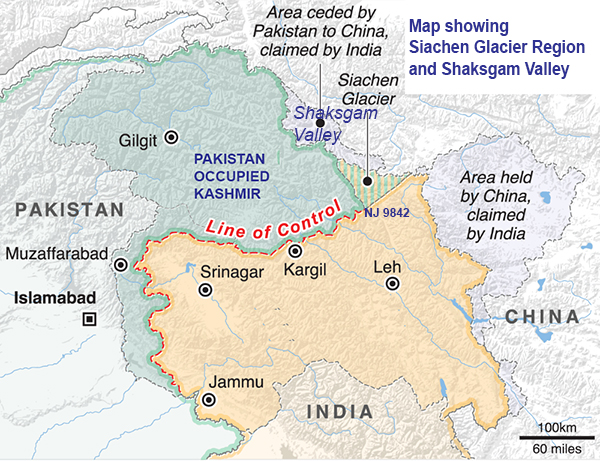Should Siachen Glacier Be Held at All Costs?
Chief of Army Staff Gen MM Naravane, on January 12, replying to a question submitted in advance, said, “We are not averse to the demilitarization of the glacier but the pre-condition for that is to accept the AGPL. Pakistan has to accept what are their positions and what are ours, and both of us have to sign on the dotted line before any kind of disengagement takes place.”
Stalemate in Talks
There have been 13 rounds of talks on the demilitarisation of Siachen, the last one at Rawalpindi in June 2012. After almost a ten-year hiatus, Gen Naravane’s statement shows that there is no progress.
India has been insisting on the marking of the current positions that the Army holds on maps that are to be ratified by both sides. This will establish Indian territorial control along the Saltoro range. On the other hand, Pakistan has been reluctant to authenticate Indian positions as it will legitimise India’s ‘illegal act’ of violating the Simla Agreement by occupying an area that was under Pakistan’s administrative control. The crux of the matter is that neither side is willing to make any territorial compromise.
After the fifth round of talks in June 1989, the joint statement stated: “There was agreement by both sides to work towards a comprehensive settlement, based on redeployment of forces to reduce the chance of conflict.” This was a direct result of Rajiv Gandhi and Benazir Bhutto’s political intervention in attempting to find a solution on Siachen.
The sixth round in 1992 carried forward the discussions of 1989, and this was the second time that an agreement was almost reached. However, there was no political acceptance by then-Prime Minister Narsimha Rao to ratify the agreement. In 2006, a draft agreement was drawn up for a phased, mutual withdrawal and joint monitoring of a demilitarised zone at Siachen.
Importance of Siachen
Lt Gen V R Raghavan, who served as the Director-General of Military Operations, wrote in his book Siachen: Conflict without End: “It is apparent that neither India nor Pakistan secures a strategic advantage by contesting the possession of the Saltoro range. Neither also faces a military threat to the territory it occupies in Jammu and Kashmir from over the Saltoro range…A strategic veneer is given to what is actually a political necessity for continuing the conflict.”
On the other hand, the area is bound by Pakistan to the west, the Chinese Shaksgam valley to the North, and the Sub Sector North (SSN) of Ladakh to the east, where the People’s Liberation Army (PLA) is confronting the Indian Army in the Depsang plains. If military collusion between Pakistan and China is to occur, this is the area where it is most likely to happen.


Shaksgam Valley
While Gen Naravane spelt out the Indian Army’s position on the issue, the matter has become far more complicated for national security planners with Pakistan and China proposing a road connecting Yarkand in Sinkiang to Muzaffarabad in Pakistan Occupied Kashmir through Shaksgam Valley, a 5193-square-kilometres territory that Pakistan illegally ceded to China in 1963. The Shaksgam Valley lies in the trans-Karakoram range watershed.
Area maps clearly show that Rimo Glacier, Teram Shehr Glacier and the Siachen Glacier are located within the Indian union territory of Ladakh. The adjoining areas of these glaciers are PLA dominated territories like Shaksgam Valley and Yarkand Valley in the north and PoK in the west in addition to the warlike deployments by the PLA in Aksai Chin opposite Daulat Beg Oldi sector in the east. The PLA has a history of aggressive transgressions into what the Army calls sub-sector north and it is adamant in blocking the Indian Army patrols in Depsang Bulge south of DBO.
The proposed Muzaffarabad-Shaksgam-Yarkand Valley road will not only boost the military interoperability between two iron brothers but also pose a two-front threat to Indian forces in the sub-sector north.
The Indian Army controls the Saltoro Ridge that provides ingress into Siachen Glacier since 1984 post-Operation Meghdoot. Siachen Glacier is located in the eastern Karakoram range, just northeast of NJ 9842, where the Line of Control between India and Pakistan ends.
The military situation in the area is quite precarious with China building all-weather access to Pakistan via Karakoram Pass, just 18 km from DBO plateau, and trying to militarily impose India rejected 1959 line on the LAC in Ladakh.
Historical Background
Siachen is a part of the former state of Jammu and Kashmir (now divided into two Union territories — Jammu & Kashmir and Ladakh), which legally acceded to India on October 26-27, 1947 and has since then been its integral part. This was endorsed by every political party in the land, and both Houses of the Indian Parliament passed an unanimous resolution on February 22, 1994 that the State of Jammu and Kashmir has been, is and shall be an integral part of India!
It was in the later years of the 1970s that the India side picked up activities by Pakistan in the Siachen area, such as sponsoring international mountaineering expeditions. This would have implied that Pakistan had jurisdiction over this territory. This was also the time when official US maps began to show the LoC as extending right up to the Karakoram Pass on the India-China boundary, which would, in effect, imply that the Siachen glacier fell under the actual jurisdiction of Pakistan. The Chinese followed suit. As a result, roughly 2,300 sq km of territory in this glacier zone came to be shown as under Pakistani control. In response to this encroachment, the Indian Army launched what came to be known as Operation Meghdoot, in 1984, to occupy the Siachen-Saltoro ridge. Pakistani attempts to dislodge the Indian troops from the heights did not succeed though they did occupy and fortify the lower reaches on their side.
Comments
Brookings scholar Stephen Cohen said: “Siachen is a conflict between two bald men over a comb.” The cost of Siachen expedition over the years has been around 2,150 soldiers killed and 5,000 persons wounded on both sides with an estimated cost of roughly $1 million a day.
Any move to withdraw from our territory will also be a violation of the Constitution by India’s rulers. The reality is, Siachen can’t be a discussion point except for its acceptance and recognition as an integral/inviolable part of India.
In the best of times, India and Pakistan were engaged in what was known as a Composite Dialogue, the agenda for which contained eight items. Siachen and Sir Creek were two issues on which early agreement was possible.
It is true that the AGPL delineation had been a major sticking point in reaching an agreement on Siachen. However, this matter had been resolved between the two sides, first during bilateral defence secretary-level talks in 1992 and then subsequently in foreign secretary-level talks in 2006. These agreements could not be formalised and implemented due to political reasons.
Can Pakistan or China be relied upon for their diplomatic assurances?
It would be militarily prudent for Indian Army to put the demilitarization of Siachen on the back-burner till such time the Chinese PLA agrees to respect the Ladakh LAC and restores April 2020 status quo ante as well as allow India unhindered rights to patrol Depsang Bulge and Charding Nullah Junction (CNJ) in Demchok sector.



















